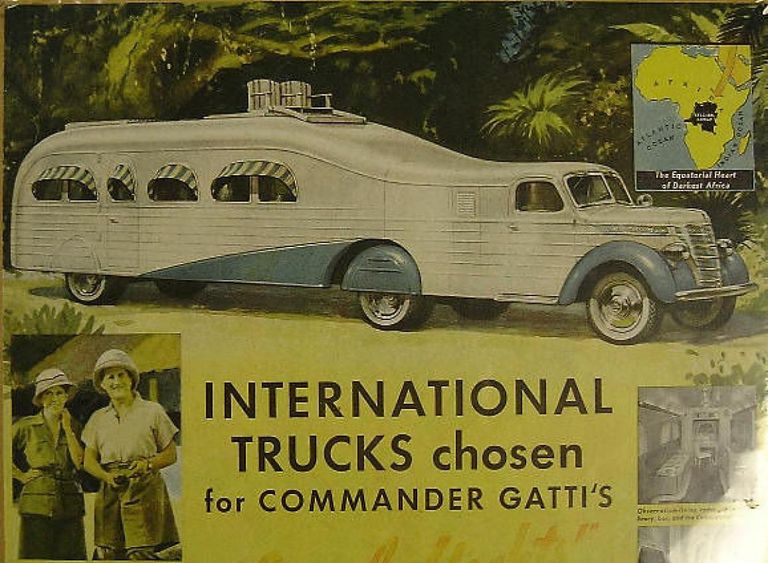A Brief History of RVs

Throughout modern American history, the RV has grown to symbolize adventure and the nomadic spirit. Today, RV and campervan sales are at an all-time high, and the #vanlife has enjoyed several years of notoriety and growth. However, this evolution began long before your Instagram feed was brimming with stylized, renovated buses, luxury coaches, and campervans. Lucky for us, these beautiful contemporary RVs and campervans provide unique insight into the growth of a great American pastime and the rich history of travel and recreational vehicles.
So, what was the first RV or camper?
Arguably, camper vehicles date back as far as the nineteenth century, but the first consumer campervan that’s easily recognized as a modern predecessor was the Pierce-Arrow's Touring Landau, which entered production in 1910 and cost a whopping $8,000: well over $200,000 in today’s dollars 😳. Although the Touring Landau began as a limousine, the manufacturer made the bold decision to offer a bench seat that folded into a bed. However, the most impressive amenities for the time were a sink and toilet with functioning plumbing and a phone that allowed passengers to connect with the driver. Imagine it: during a time when a not-insignificant number of people in the country went without running water in their homes, the Touring Landau offered functional plumbing in a converted limo!
As for the first RV, five years later, in 1915, the Roland Conklin Gas-Electric Motor Bus Company's Gypsy Van landed on the market. The double-deck Gypsy Van could house up to 17 passengers and boasted amenities similar to today's modern RVs. Inside the Gypsy Van, you could whip up a meal in the kitchenette, enjoy a full shower, appreciate the most modern appliances, and store your favorite tchotchkes and books on a concealed bookcase.
These two vehicles—the Touring Landau and the Gypsy Van—gave way to the "tin-can tourist" movement. Tin-can tourists were individuals known for surviving out of their vehicles for weeks at a time. In 1919, the organization was formally recognized. Members were required to be at least 12 years old, demonstrate strong moral character, and live a nomadic life by choice. Two years later, in 1921, the organization had grown to an impressive 17,000+ members.
The evolution of the RV
As nomadic vehicles grew in popularity, versatile, more affordable options quickly hit the market. Tent campers became widely popular, but many people noticed that they had several setbacks in early production. One camper in particular, Arthur Sherman, found himself caught in one too many thunderstorms when attempting to erect his tent camper to no avail. Full of frustration, he became determined to create a solid-body waterproof camping solution.
Sherman began by constructing a single unit intended for family camping, and he soon noticed that fellow campers were fascinated by his creation. He entered his "Covered Wagon" into the Detroit Auto Show and quickly realized that he had stumbled his way into an untapped market. The solid-body industry exploded as the 1930s drew to a close, selling over 20,000 units annually thanks to one frustrated camper. Thus, the demand for modern, solid-body recreational vehicles took flight.
RVs of today: which one’s right for me?
The features, appearances, and purposes of the RVs of yesterday still echo through the market today; even as mechanics and manufacturing have evolved, our basic needs and wants haven’t changed that much over the last century. Adventurous twenty-first-century Americans now choose from a veritable smorgasbord of options for how to hit the road. Camping vehicles can be hauled or motorized and come in various shapes and sizes.
As more individuals make their biggest journeys in RVs, the demand for versatility and a wide variety of styles has never been greater. Modern options are endless, from conversion buses and vans to luxurious and elegant coaches and heavy-duty off-grid campervans. Understanding the fundamental differences between RV classes and types is an important starting point for determining which RV best fits your needs.
Here is a quick breakdown of today's RV options and classes in 2024:
Class A
Top-of-the-line luxury and amenities, ranging from 29' to 45' designed for touring with elegance and class.
Class B
Sometimes referred to as a "sprinter," since it is often built on a Mercedes Sprinter van chassis, this 18-24' RV is a quick and flexible way to take spontaneous trips while offering peak amenities and versatile storage options.
Class C
The amenities and comforts of a Class A coach with the versatility and convenient size of Class B.
Super C
Similar to Class C but often as luxurious as Class A, these RVs feature a heavy-duty front-engine chassis and run on diesel fuel.
Toy Haulers
A top-notch luxury RV with the storage capacity of a cargo hauler, this type of RV allows you to bring your toys without sacrificing precious living space for storage.
Travel Trailers
Lightweight, compact, towable modern homes with a wide array of interior options.
Shop modern-day RVs for sale at Transwest
Whether you are looking to convert a bus or van into a living space or hoping to hit the road in a luxury class A, our team at Transwest will help you find the perfect travel vehicle. No matter your style, we are here to help you locate the ideal RV for your upcoming adventures. With a quality selection of RVs from today’s finest manufacturers, we have something for any traveler's needs. Find a Transwest dealer near you, or browse our online storefront - Visit us today and hit the road tomorrow!









Share
Email
Facebook
SMS
Twitter